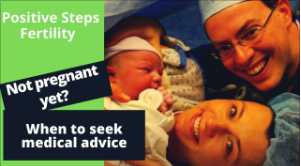After they have their first child, most people believe that their fertility issues, if they had any, are behind them. However, according to Medical News Today, “secondary infertility affects approximately 11% of couples in the United States.” Secondary infertility can occur in males and females alike, and it can be caused by various health factors.
For many, that is the case. However, some wanting to expand their family further may face unforeseen challenges with conceiving a second time. This experience, known as secondary infertility, can be emotionally taxing and fraught with uncertainty.
According to the American College of Obstetricians and Gynecologists (ACOG), signs of secondary infertility include trouble conceiving despite regular, unprotected intercourse for six months to a year, irregular menstrual cycles, and symptoms of hormonal imbalances such as sudden weight changes, skin issues, and changes in libido. Other signs can include heavy or painful periods, pelvic pain, and complications from previous pregnancies like miscarriage or cesarean section. Additionally, men and women may experience changes in sexual function, and advancing age can further complicate fertility.
Let’s take a closer look at secondary infertility, why it can occur, and how it can be treated.
What is Secondary Infertility?
Secondary infertility is defined as the inability to conceive or carry a pregnancy to term after previously giving birth to one or more children. While primary infertility (the inability to conceive a first child) often receives more attention, secondary infertility is a significant issue affecting millions of individuals and couples worldwide.
Difference Between Secondary Infertility and Primary Infertility
Secondary infertility refers to the difficulty in conceiving or carrying a pregnancy to term after previously having one or more children without the use of fertility treatments. In contrast, primary infertility is characterized by the inability to conceive or carry a pregnancy to term in individuals or couples who have never had a successful pregnancy.
5 Potential Causes of Secondary Infertility
Numerous factors can contribute to secondary infertility. Before listing these possible causes, it is important to know that this is not an exhaustive list, nor should it be used to self-diagnose. If you are struggling with infertility, start by reaching out to a fertility specialist who can assess your health and coordinate the proper care based on your circumstances. That said, here are some of the factors that can contribute to secondary infertility:
- Age: As individuals age, fertility declines, making it more challenging to conceive naturally.
- At the age of 25, a vast majority of a woman’s eggs, around 80-90%, are chromosomally normal.
- However, by the time a woman reaches 40, approximately three-fourths of her eggs are chromosomally abnormal, which means that during a year, only about three months offer a fair chance of conception with a chromosomally normal egg.
- Additionally, men’s sperm count and quality decreases with age, making conception potentially more challenging.
- Changes in Reproductive Health: Factors such as hormonal imbalances, irregular menstrual cycles, or changes in ovulation patterns can affect fertility.
- Thyroid disorders, diabetes, ovarian cysts, and many other conditions can cause fluctuation in hormones, and, consequently, ovulation patterns, which in turn can affect fertility outcomes.
- Underlying Medical Conditions: Conditions such as endometriosis, polycystic ovary syndrome (PCOS), or pelvic inflammatory disease (PID) can impact fertility.
- Similar to hormonal imbalances, underlying or preexisting conditions that may or may not have been present during your first pregnancy can still become an issue for those experiencing secondary infertility.
- Previous Pregnancy Complications: Complications during previous pregnancies, such as miscarriage, stillbirth, or cesarean section, can increase the risk of secondary infertility.
- Lifestyle Factors: Obesity, smoking, excessive alcohol consumption, or stress can negatively impact fertility.
- We cover this topic in detail in this post. Still, if your lifestyle habits have changed since your first pregnancy, it is possible that these new factors could play a role in your inability to conceive a second time.
Exploring Secondary Infertility Treatment Paths
When faced with secondary infertility, individuals and couples often wonder about the available treatment options. Each case is unique and should be discussed with your fertility specialist after a consultation and preliminary round of testing. Here are some common approaches that fertility specialists consider:
1. Lifestyle Modifications
Before exploring medical interventions, consider making lifestyle changes that can positively impact fertility:
- Maintain a Healthy Weight: Obesity or extreme underweight can affect hormonal balance and ovulation. Achieving a healthy weight can improve fertility.
- Quit Smoking and Limit Alcohol: Smoking and excessive alcohol consumption can harm reproductive health. Quitting smoking and moderating alcohol intake are essential.
- Manage Stress: Chronic stress can disrupt hormonal balance. Practice stress-reducing techniques such as meditation, yoga, or counseling.
2. Ovulation Induction
For individuals with irregular ovulation, ovulation induction may be recommended. This involves using medications (such as Letrozole) to stimulate ovulation. Regular monitoring and timed intercourse are essential during this process.
3. Intrauterine Insemination (IUI)
IUI is a minimally invasive procedure where washed and prepared sperm are directly placed into the uterus during the woman’s fertile window. It is often used when sperm quality is a concern or when ovulation induction alone is insufficient.
If secondary infertility becomes a roadblock to natural conception, methods like IUI present a potential alternative for fertilization.
4. In Vitro Fertilization (IVF)
IVF is a more advanced treatment option. It involves stimulating the ovaries to produce multiple eggs, retrieving those eggs, fertilizing them with sperm in the laboratory, and transferring the resulting embryos back into the uterus. IVF is effective for various fertility issues, including secondary infertility.
5. Surgery
In some more severe cases, surgical interventions may be necessary. For example:
- Hysteroscopy: To remove uterine polyps, fibroids, or scar tissue.
- Laparoscopy: To treat endometriosis, pelvic adhesions, or blocked fallopian tubes.
6. Assisted Reproductive Technologies (ART)
ART encompasses various techniques beyond IVF:
- Intracytoplasmic Sperm Injection (ICSI): Used when male factor infertility is present. A single sperm is directly injected into an egg.
- Preimplantation Genetic Testing (PGT): Screens embryos for genetic abnormalities before transfer.
- Egg or Sperm Donation: When using one’s own sperm and/or eggs is not feasible.
Once again, whether these treatments are necessary depends on each individual’s circumstances. Consult a specialist to determine what the right path forward is for you on your fertility journey.
Coping with Secondary Infertility: Navigating the Journey
Navigating the journey of fertility can be emotionally challenging, but here are some steps individuals and couples experiencing secondary infertility can take to cope with the experience:
- Seek Support: Reach out to trusted friends, family members, or support groups who can provide understanding, empathy, and encouragement during this difficult time. Talking openly about your feelings and experiences can help alleviate isolation and loneliness.
- Educate Yourself: Take the time to educate yourself about secondary infertility, its potential causes, and treatment options. Knowledge is empowering and can help you make informed decisions about your fertility journey.
- Consult with Fertility Specialists: Schedule an appointment with a reproductive endocrinologist or call us to have your fertility health comprehensively evaluated. They can conduct tests to identify underlying issues and recommend appropriate treatment options.
Most important in this process is to find a fertility clinic that is not only well-equipped to serve your physical needs but also helps you through the emotional rollercoaster that is dealing with infertility. Find a team that supports you emotionally, educates you exhaustively, and provides the utmost care for you as you go along this journey.
At Positive Steps, we pride ourselves on securing the best patient outcomes and treating our patients like family throughout their journey, from consultation to conception. Read here to see a couple’s testimonial about their experience with Positive Steps.
Regardless of the clinic you choose, do not be afraid to reach out for help if you are struggling with secondary infertility. Don’t suffer in silence. Call us today.
Find answers. Find peace.
Dr. Preston Parry




